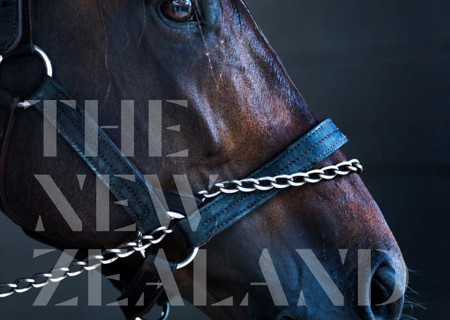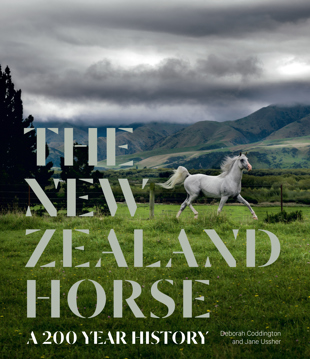1. You’ve travelled from north to south to create this book. Was that a pleasure?
DC: A privilege, a pleasure, and hard work.
JU: The spectacular locations often dictated the way I photographed each section of the book and, in most cases, were as inspiring as the horses themselves. Very early on I decided that the way I was going to structure the book was not only to take photographs to celebrate the horse but also to celebrate the New Zealand landscape. It was an amazing opportunity.
2. What are a couple of the really special encounters you had?
DC: Being taken behind the scenes at Addington on race day when the harness racers were prepped. The smells, the sounds, the people — it was rare to not be halted by health and safety bureaucracy and to be allowed access to the immediacy of the action and to experience the horses’ excitement as they waited their turn to be taken out to race. At Waikato Stud in spring: the waiting, waiting, waiting for a foaling, then rushing out in our PJs and puffer jackets to catch on camera the valuable new life slip out onto the morning grass. Always a special moment.
JU: Watching three-year-old Esmé Stephenson and the level of trust she had in her huge Stationbred horse, Othello, and seeing the Kaimanawa horses running wild before the muster.
3. Is there a particular horse that has stayed in your mind?
DC: Pip, unfortunately, who died a dreadful painful death at the hands of his cruel owner; that was the only text I wrote in anger. Thankfully in New Zealand, legislation now makes it easier to prosecute, and lawyers generously offer their services free of charge.
JU: Zibaq Khan, the beautiful Arabian stallion and the love he had for his owner Karan Lawrence.
4. What’s one new thing you learnt about horses while working on the book?
DC: That a surprising number of horses don’t like being photographed. For instance, when Jane was photographing young racehorses being trained on the track early one morning at Waikato Stud, it became a bit fraught when they started shying away from her as they galloped around the home bend. The young apprentice was nearly tipped out of her saddle.
JU: Not surprisingly, observing the relationship between horse and rider and how much a horse will push itself to please when it’s loved unconditionally and treated with respect.
5. And another new thing?
DC: That other horses, particularly the glorious Thoroughbred, Spanish and Arab stallions, adored posing for the camera. You can see it in the photographs — look at their proud eyes.
JU: That I really like being around horses.
6. What contribution do you hope the book will make to New Zealand's regard for horses?
DC: I’m biased, but horses are amazing animals; a level above all others, and they have made an extraordinary contribution to the building of this nation. I hope the book reflects this.
JU: In some cases it will be preaching to the choir — all the horse people I met had a huge amount of love and respect for their animals — but other New Zealanders like me look for opportunities to engage with these amazing animals.
7. Over the past year you’ve spent many hours observing the intense bond between many New Zealanders and their horses. What do you think is at the base of that bond?
DC: The best horse people know there’s no room for a romantic ‘horse-whispering’ type relationship. Horses must trust people, but they need direction, boundaries and to know that their owners are in charge. We are responsible for them and if we don’t commit to that, they end up being unmanageable and having to be euthanised or, worse, abused and neglected.
JU: Trust.
8. Did working on the book inspire you to leap into the saddle and gallop off?
DC: In 2016, when my Quarter Horse Smitty (aged 30) and Stationbred Lily (aged 28) had to be euthanised, I gave up riding. But writing this book recharged my desire. I’ve owned horses all my life and at the age of 65 it’s great to be back in the saddle (albeit on other peoples’ horses). You never un-learn horsemanship, and you’re never too old to ride.
JU: No — in the same way that I can photograph a mountaineer and never want to climb a mountain — but there is nothing more satisfying to a non-rider than watching an experienced horsewoman or -man riding well.
9. You are both experienced at delivering to editors and publishers on time, but even so you must feel the pressure of deadlines. What are your strategies for when the going gets tough?
DC: Self-discipline. My journalism training kicks in.
JU: Having a clear focus on how you are going to structure a book is key for me. Once that is done, planning, communication and working out the logistics always gives you a sense of control even if it proves to be an illusion. I always have a back-up plan approaching deadline.
10. What are you each reading at the moment?
DC: God Save Texas — A Journey into the Future of America by Lawrence Wright.
JU: Less by Andrew Sean Greer.


